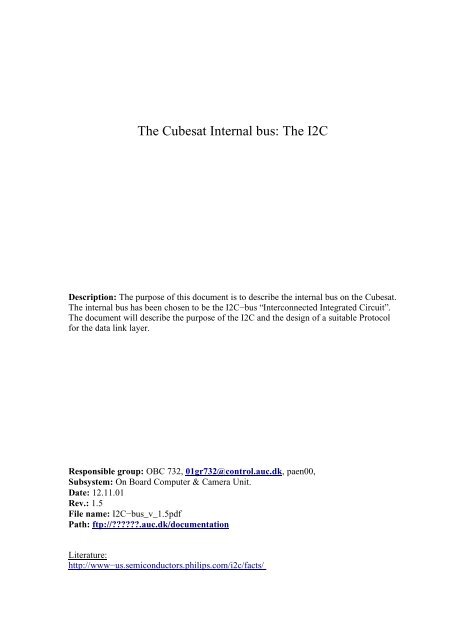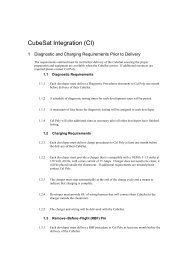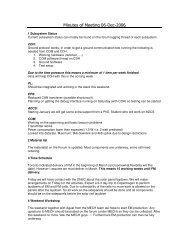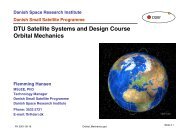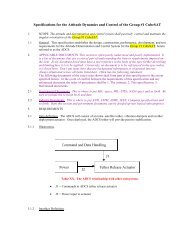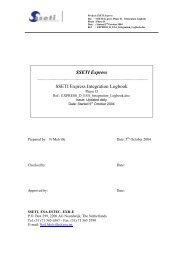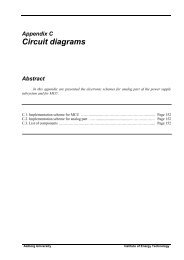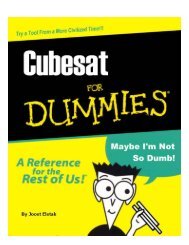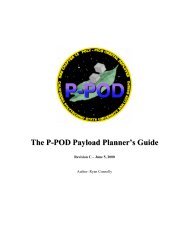The Cubesat Internal bus: The I2C - Space.aau.dk
The Cubesat Internal bus: The I2C - Space.aau.dk
The Cubesat Internal bus: The I2C - Space.aau.dk
- No tags were found...
Create successful ePaper yourself
Turn your PDF publications into a flip-book with our unique Google optimized e-Paper software.
<strong>The</strong> <strong>Cubesat</strong> <strong>Internal</strong> <strong>bus</strong>: <strong>The</strong> <strong>I2C</strong>Description: <strong>The</strong> purpose of this document is to describe the internal <strong>bus</strong> on the <strong>Cubesat</strong>.<strong>The</strong> internal <strong>bus</strong> has been chosen to be the <strong>I2C</strong>−<strong>bus</strong> “Interconnected Integrated Circuit”.<strong>The</strong> document will describe the purpose of the <strong>I2C</strong> and the design of a suitable Protocolfor the data link layer.Responsible group: OBC 732, 01gr732@control.auc.<strong>dk</strong>, paen00,Subsystem: On Board Computer & Camera Unit.Date: 12.11.01Rev.: 1.5File name: <strong>I2C</strong>−<strong>bus</strong>_v_1.5pdfPath: ftp://??????.auc.<strong>dk</strong>/documentationLiterature:http://www−us.semiconductors.philips.com/i2c/facts/
1. IntroducciónDe la Guerra Civil Española se ha hablado y escrito mucho, pero salvo excepciones, casisiempre se ha hecho desde un punto de vista transversal, analizando el momento. Esteartículo, por el contrario, pretende aproximarse desde un punto de vista longitudinal a lasposibles diferencias entre el efectivo movilizado en provincias Nacionales, y el que lo fue enprovincias Republicanas en términos de la duración de la movilización y de la entrada en elmercado de trabajo.En esta ocasión, se estudiaran las consecuencias del conflicto para cada una de lasgeneraciones que participaron activamente en él; es decir, para aquellos que fueron llamadosal frente con 18, 19, 20 o 21 años, y para los que posiblemente la guerra no acabó en el 39.3
Acknowledge:Data transfer with acknowledge is obligatory. <strong>The</strong>acknowledge−related clock pulse is generated by the master. <strong>The</strong>transmitter releases the SDA line (HIGH) during the acknowledgeclock pulse.<strong>The</strong> receiver must pull down the SDA line during the acknowledgeclock pulse so that it remains stable LOW during the HIGH period ofthis clock pulse, in order to confirm that it is willing to communicate.Header:Length:<strong>The</strong> first three bits of the header determine how many data packages the header will befollowed by (up to 8 * 8 bit data packages).HeaderNo of data Packages000xxxxx 1001xxxxx 2010xxxxx 3011xxxxx 4100xxxxx 5101xxxxx 6110xxxxx 7111xxxxx 8Module:<strong>The</strong> device module number. E.g. <strong>The</strong> PSU temp probe nr. 2 (2*8 bit data) [00100010].<strong>The</strong> total amount of modules you can address is 2^5 = 32Data:<strong>The</strong> data on the SDA line must be stable during the HIGH period ofthe clock. <strong>The</strong> HIGH or LOW state of the data line can only changewhen the clock signal on the SCL line is LOWStop:A LOW to HIGH transition on the SDA line while SCL is HIGH
defines a STOP condition.Checksum:<strong>The</strong> data package following the header is an 8 bit CRC Checksum.<strong>The</strong> checksum is calculated in the following way.All the data packages send in one transmission is added together, the 8 bit result of thiscalculation yields the CRC checksum. <strong>The</strong> received data is calculated in the same wayand the last calculated checksum is subtracted from the “original” checksum. <strong>The</strong> resultnow indicates weather the transmitted data is corrupted. If the result is different from 0the data is corrupted and will be retransmitted.Send data Received data[01101101] [01101101]+ +[10110101] [10110101]= =1[00100010] − 1[00100010] = 0 <strong>The</strong> data is ok.Communication Master−Slave Slave−Master:Possible data transfer formats are:· Master−transmitter transmits to slave−receiver. <strong>The</strong> transfer direction is not changed(see Fig.2).· Master reads slave immediately after first byte (see Fig.2). At the moment of the firstacknowledge, the master− transmitter becomes a master− receiver and the slave−receiverbecomes a slave−transmitter. This first acknowledge is still generated by the slave. <strong>The</strong>STOP condition is generated by the master, which has previously sent a not−acknowledge (A).· Combined format (see Fig.2). During a change of direction within a transfer, theSTART condition and the slave address are both repeated, but with the R/W bit reversed.If a master receiver sends a repeated START condition, it has previously sent a not−acknowledge (A).NOTES:1. Combined formats can be used, for example, to control a serial memory. During thefirst data byte, the internal memory location has to be written. After the STARTcondition and slave address is repeated, data can be transferred.2. All decisions on auto−increment or decrement of previously accessed memorylocations etc. are taken by the designer of the device.3. Each byte is followed by an acknowledgment bit as indicated by the A or A blocks inthe sequence.
4. I 2 C−<strong>bus</strong> compatible devices must reset their <strong>bus</strong> logic on receipt of a START orrepeated START condition such that they all anticipate the sending of a slave address,even if these START conditions are not positioned according to the proper format.5. A START condition immediately followed by a STOP condition (void message) is anillegal format.FIGUR 2 Possible data transfer formatsConducting housekeepingWhen collecting housekeeping from the different units the master only needs to addressa unit and set the R/W condition to “Read”, <strong>The</strong> unit then delivers all its housekeeping data to the MCU. Each sensor on a unit is identified by the module number transmitted in the header.Controlling UnitsWhen controlling a unit from the MCU, the MCU will of course have to send data alongwith the address, header and checksum.Further information about the <strong>I2C</strong>−<strong>bus</strong> can be found at.http://www−us.semiconductors.philips.com/i2c/facts/


